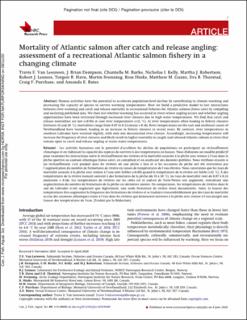Mortality of Atlantic salmon after catch and release angling: assessment of a recreational Atlantic salmon fishery in a changing climate
Van Leeuwen, Travis E.; Dempson, J. Brian; Burke, Chantelle M.; Kelly, Nicholas I.; Robertson, Martha J.; Lennox, Robert J.; Havn, Torgeir Børresen; Svenning, Martin; Hinks, Ross; Guzzo, Matthew M.; Thorstad, Eva Bonsak; Purchase, Craig F.; Bates, Amanda E.
Peer reviewed, Journal article
Published version

Åpne
Permanent lenke
https://hdl.handle.net/11250/2671784Utgivelsesdato
2020Metadata
Vis full innførselSamlinger
- Publikasjoner fra CRIStin - NINA [2364]
- Scientific publications [1392]
Originalversjon
10.1139/cjfas-2019-0400Sammendrag
Human activities have the potential to accelerate population-level decline by contributing to climate warming and decreasing the capacity of species to survive warming temperatures. Here we build a predictive model to test interactions between river warming and catch and release mortality in recreational fisheries for Atlantic salmon (Salmo salar) by compiling and analyzing published data. We then test whether warming has occurred in rivers where angling occurs and whether angling opportunities have been restricted through increased river closures due to high water temperatures. We find that catch and release mortalities are low (<0.05) at cool river temperatures (<12 °C). At river temperatures often leading to fishery closures (between 18 and 20 °C), mortalities range from 0.07 to 0.33 (mean = 0.16). River temperatures on the east and southeast coasts of Newfoundland have warmed, leading to an increase in fishery closures in recent years. By contrast, river temperatures in southern Labrador have warmed slightly, with only one documented river closure. Accordingly, increasing temperatures will increase the frequency of river closures and likely result in higher mortality in caught and released Atlantic salmon in rivers that remain open to catch and release angling at warm water temperatures.